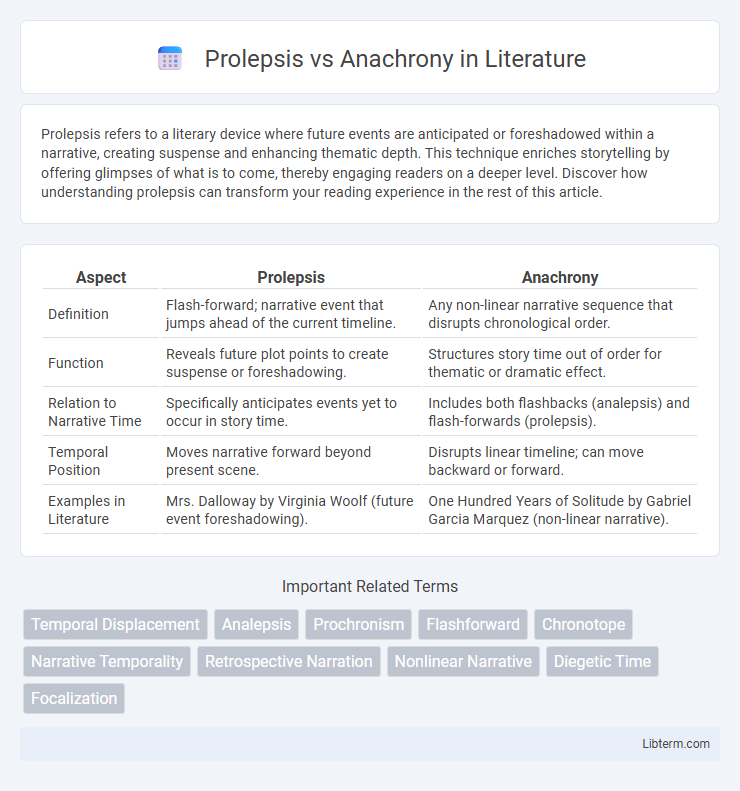Prolepsis refers to a literary device where future events are anticipated or foreshadowed within a narrative, creating suspense and enhancing thematic depth. This technique enriches storytelling by offering glimpses of what is to come, thereby engaging readers on a deeper level. Discover how understanding prolepsis can transform your reading experience in the rest of this article.
Table of Comparison
| Aspect | Prolepsis | Anachrony |
|---|---|---|
| Definition | Flash-forward; narrative event that jumps ahead of the current timeline. | Any non-linear narrative sequence that disrupts chronological order. |
| Function | Reveals future plot points to create suspense or foreshadowing. | Structures story time out of order for thematic or dramatic effect. |
| Relation to Narrative Time | Specifically anticipates events yet to occur in story time. | Includes both flashbacks (analepsis) and flash-forwards (prolepsis). |
| Temporal Position | Moves narrative forward beyond present scene. | Disrupts linear timeline; can move backward or forward. |
| Examples in Literature | Mrs. Dalloway by Virginia Woolf (future event foreshadowing). | One Hundred Years of Solitude by Gabriel Garcia Marquez (non-linear narrative). |
Defining Prolepsis and Anachrony
Prolepsis refers to a narrative technique where future events are presented ahead of their chronological occurrence, creating anticipation and foreshadowing within the story structure. Anachrony encompasses any deviation from the chronological sequence of events, including both prolepsis (flash-forwards) and analepsis (flashbacks), disrupting linear storytelling to enhance thematic depth and character development. Understanding prolepsis and anachrony is crucial in narratology for analyzing non-linear timelines and their impact on audience engagement and narrative comprehension.
Historical Background of Narrative Techniques
Prolepsis and anachrony are narrative techniques rooted in classical rhetoric and literary theory, where prolepsis refers to the anticipation of future events within a narrative, while anachrony involves the disruption of chronological order through flashbacks or flashforwards. The historical background of these techniques is traced to Aristotle's Poetics, which influenced the formal study of plot structures and time manipulation in storytelling. Over centuries, these concepts evolved through Roman rhetoric and Renaissance literature, becoming foundational in modern narratology for analyzing temporal shifts in narrative discourse.
Key Differences Between Prolepsis and Anachrony
Prolepsis refers specifically to a narrative technique where future events are presented ahead of their chronological occurrence, often as a form of flash-forward. Anachrony encompasses any disruption in the chronological order of a narrative, including both prolepsis (flash-forwards) and analepsis (flashbacks), making it a broader term. The key difference lies in scope: prolepsis is a type of anachrony focused on future events, while anachrony covers all temporal displacements in storytelling.
The Role of Time in Storytelling
Prolepsis and anachrony manipulate narrative time to enrich storytelling by altering the chronological sequence of events. Prolepsis, or flashforward, reveals future occurrences to create suspense or foreshadow outcomes, while anachrony encompasses all deviations from chronological order, including both flashbacks (analepsis) and flashforwards (prolepsis). These temporal shifts enable authors to deepen character development, enhance thematic complexity, and engage audiences by controlling the flow of information across the narrative timeline.
Prolepsis in Literary Examples
Prolepsis in literature refers to a narrative technique where future events are depicted out of chronological order, creating suspense or foreshadowing outcomes, as seen in Homer's "The Iliad" when the poet describes Achilles' eventual death before it occurs. Shakespeare's "Macbeth" uses prolepsis through the witches' prophecies, which reveal Macbeth's fate ahead of the story's present timeline. This technique enhances thematic depth by allowing readers to anticipate consequences and understand characters' motivations within a non-linear temporal framework.
Anachrony in Modern Narratives
Anachrony in modern narratives disrupts the chronological sequence by employing flashbacks, flashforwards, and non-linear plot structures to create complex temporal layers within storytelling. This technique enhances narrative depth and audience engagement by revealing backstories and foreshadowing future events, often reflecting characters' psychological states or thematic motifs. Contemporary novels, films, and digital media frequently use anachrony to challenge traditional narrative progression and emphasize the relativity of time in human experience.
Effects on Reader Engagement
Prolepsis, by revealing future events early, generates suspense and curiosity, compelling readers to anticipate outcomes and remain engaged. Anachrony disrupts chronological flow, prompting readers to actively piece together timelines, which enhances cognitive involvement and deepens narrative immersion. Both techniques create a dynamic reading experience by manipulating temporal perception, thereby sustaining reader attention and emotional investment.
Common Misconceptions
Prolepsis is often mistakenly equated solely with flashforward, while it also encompasses anticipatory narration that reveals future events within the present narrative timeline. Anachrony broadly refers to any disruption in chronological order, including both prolepsis (flashforward) and analepsis (flashback), yet many confuse it as a synonym for only one of these techniques. Understanding that prolepsis is a subset of anachrony clarifies narrative structures and removes the common misconception that these terms are interchangeable.
Analyzing Prolepsis and Anachrony in Film
Analyzing prolepsis and anachrony in film reveals how narrative time manipulation enhances storytelling by disrupting chronological order to create suspense or deepen character development. Prolepsis, or flashforward, projects future events to foreshadow outcomes, while anachrony encompasses both flashbacks and flashforwards, emphasizing the temporal dislocation within the plot structure. Filmmakers utilize these techniques to engage viewers intellectually and emotionally, enriching plot complexity and thematic resonance through strategic temporal shifts.
Conclusion: Choosing the Right Technique
Prolepsis and anachrony serve distinct narrative functions by manipulating chronological order to enhance storytelling. Prolepsis involves anticipating future events to create suspense or foreshadowing, while anachrony encompasses any deviation from chronological sequence, including flashbacks and flash-forwards, to deepen plot understanding. Selecting the appropriate technique depends on the narrative's purpose: use prolepsis to build anticipation and anachrony to reveal backstory or contextual layers effectively.
Prolepsis Infographic

 libterm.com
libterm.com